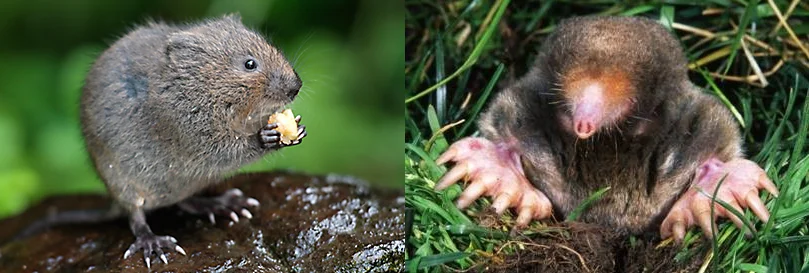Voles and moles are two of the most destructive creatures to lawns this time of year in West Michigan. Although they have similar sounding names, they are quite different animals. Voles are very mouse-like in appearance, small and reddish to dark brown in color. And, similar to mice, they can reproduce and colonize rather quickly. Moles, on the other hand, are known for their long noses and long, webbed front feet which help them tunnel quickly. They are typically six to seven inches long and gray to dark brown in color.
Voles and moles also cause very different types damage to lawns due to their different appetites. Voles are plant-eaters who primarily feed on grass and perennial flower roots. They will also munch on seeds, bulbs, and even bark. This activity leads to surface pathways that lead from one hole to another. Damage is especially apparent after the snow melts, as the voles will be active under the snow and on top of the land. Moles, on the other hand, are insectivores with a primary diet of earthworms. They will also occasionally much on grubs and insects when they come across them. The damage they cause is due to tunneling around the lawn in search of more worms.
The most commonly used method for eradicating voles is snap-traps or poison, both of which are often marketed for mice. Other prefer more natural approaches to control vole activity, such as planting trees to encourage predators (like hawks and owls) or adopting an outdoor cat. Killing moles is also typically regarded as the most effective lawn-term control. Others prefer to trap and relocate them elsewhere.
Once you have your mole or vole activity under control, it’s time to repair any lawn damage they caused. Fortunately, lawns can typically recover pretty quickly on their own after this type of damage and rarely require reseeding. After the snow melts and the lawn starts to grow, you should see grass growth in the areas where voles made their pathways. Similarly, as it starts to warm up, you can spread dirt piles and push down runs caused by moles and the grass should simply grow like normal. This also makes it easier to later identify new, active mole runs so you can control the activity. If you have any questions, your AAA Lawn Care technician will be happy to give you recommendations, as well.

